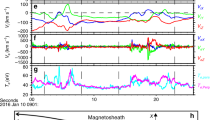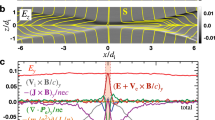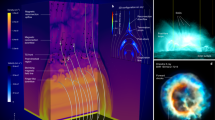Abstract
The primary target of the Magnetospheric MultiScale (MMS) mission is the electron-scale diffusion layer around reconnection sites. Here we study where these regions are found in full three-dimensional simulations. In two dimensions the sites of electron diffusion, defined as the regions where magnetic topology changes and electrons move with respect to the magnetic field lines, are located near the reconnection site. But in three dimensions we find that the reconnection exhaust far from the primary reconnection site also becomes host to secondary reconnection sites. Four diagnostics are used to demonstrate the point: the direct observation of topology impossible without secondary reconnection, the direct measurement of topological field line breakage, the measurement of electron jets emerging from secondary reconnection regions, and the violation of the frozen-in condition. We conclude that secondary reconnection occurs in a large part of the exhaust, providing many more chances for MMS to find itself in the right region to hit its target.
This is a preview of subscription content, access via your institution
Access options
Subscribe to this journal
Receive 12 print issues and online access
$209.00 per year
only $17.42 per issue
Buy this article
- Purchase on Springer Link
- Instant access to full article PDF
Prices may be subject to local taxes which are calculated during checkout




Similar content being viewed by others
References
Curtis, S. The Magnetospheric Multiscale Mission: Resolving Fundamental Processes in Space Plasmas: Report of the NASA Science and Technology Definition Team for the Magnetospheric Multiscale (MMS) Mission The Magnetospheric Multiscale Mission Resolving Fundamental Processes in Space Plasmas. (NASA, 1999).
Biskamp, D. Magnetic Reconnection in Plasmas (Cambridge Univ. Press, 2000).
Ren, Y. et al. Experimental verification of the Hall effect during magnetic reconnection in a laboratory plasma. Phys. Rev. Lett. 95, 055003 (2005).
Øieroset, M., Phan, T., Fujimoto, M., Lin, R. & Lepping, R. In situ detection of collisionless reconnection in the Earth’s magnetotail. Nature 412, 414–417 (2001).
Shay, M., Drake, J., Swisdak, M., Dorland, W. & Rogers, B. Inherently three dimensional magnetic reconnection: A mechanism for bursty bulk flows? Geophys. Res. Lett. 30, 1345 (2003).
Lapenta, G. et al. Kinetic simulations of x-line expansion in 3D reconnection. Geophys. Res. Lett. 33, L10102 (2006).
Lau, Y.-T. & Finn, J. M. Three-dimensional kinematic reconnection in the presence of field nulls and closed field lines. Astrophys. J. 350, 672–691 (1990).
Olshevsky, V., Lapenta, G. & Markidis, S. Energetics of kinetic reconnection in a three-dimensional null-point cluster. Phys. Rev. Lett. 111, 045002 (2013).
Birn, J. & Priest, E. R. Reconnection of Magnetic Fields: Magnetohydrodynamics and Collisionless Theory and Observations (Cambridge Univ. Press, 2007).
Cattell, C. et al. Cluster observations of electron holes in association with magnetotail reconnection and comparison to simulations. J. Geophys. Res. 110, A10211 (2005).
Divin, A., Lapenta, G., Markidis, S., Newman, D. L. & Goldman, M. V. Numerical simulations of separatrix instabilities in collisionless magnetic reconnection. Phys. Plasmas 19, 042110 (2012).
Lapenta, G., Markidis, S., Divin, A., Newman, D. & Goldman, M. Separatrices: The crux of reconnection. J. Plasma Phys. 81, 1–139 (2014).
Wang, R. et al. Observation of multiple sub-cavities adjacent to single separatrix. Geophys. Res. Lett. 40, 2511–2517 (2013).
Sitnov, M., Swisdak, M. & Divin, A. Dipolarization fronts as a signature of transient reconnection in the magnetotail. J. Geophys. Res. 114, A04202 (2009).
Runov, A. et al. THEMIS observations of an earthward-propagating dipolarization front. Geophys. Res. Lett. 36, L14106 (2009).
Eastwood, J. et al. Energy partition in magnetic reconnection in Earths magnetotail. Phys. Rev. Lett. 110, 225001 (2013).
Gosling, J., Skoug, R., McComas, D. & Smith, C. Direct evidence for magnetic reconnection in the solar wind near 1 AU. J. Geophys. Res. 110, A01107 (2005).
Daughton, W. et al. Role of electron physics in the development of turbulent magnetic reconnection in collisionless plasmas. Nature Phys. 7, 539–542 (2011).
Hamrin, M. et al. The role of the inner tail to midtail plasma sheet in channeling solar wind power to the ionosphere. J. Geophys. Res. 117, A06310 (2012).
Angelopoulos, V. et al. Electromagnetic energy conversion at reconnection fronts. Science 341, 1478–1482 (2013).
Birn, J. & Hesse, M. Energy release and conversion by reconnection in the magnetotail. Ann. Geophys. 23, 3365–3373 (2005).
Ashour-Abdalla, M. et al. Observations and simulations of non-local acceleration of electrons in magnetotail magnetic reconnection events. Nature Phys. 7, 360–365 (2011).
Lapenta, G., Goldman, M., Newman, D., Markidis, S. & Divin, A. Electromagnetic energy conversion in downstream fronts from three dimensional kinetic reconnection. Phys. Plasmas 21, 055702 (2014).
Eastwood, J. et al. Observations of multiple x-line structure in the Earth’s magnetotail current sheet: A Cluster case study. Geophys. Res. Lett. 32, L11105 (2005).
Retinò, A. et al. In situ evidence of magnetic reconnection in turbulent plasma. Nature Phys. 3, 236–238 (2007).
Eriksson, S., Newman, D., Lapenta, G. & Angelopoulos, V. On the signatures of magnetic islands and multiple x-lines in the solar wind as observed by ARTEMIS and WIND. Plasma Phys. Control. Fusion 56, 064008 (2014).
Moore, T., Arnoldy, R., Feynman, J. & Hardy, D. Propagating substorm injection fronts. J. Geophys. Res. 86, 6713–6726 (1981).
Moore, T. et al. Snowplow injection front effects. J. Geophys. Res. 118, 6478–6488 (2013).
Guzdar, P., Hassam, A., Swisdak, M. & Sitnov, M. A simple MHD model for the formation of multiple dipolarization fronts. Geophys. Res. Lett. 37, L20102 (2010).
Lapenta, G. & Bettarini, L. Self-consistent seeding of the interchange instability in dipolarization fronts. Geophys. Res. Lett. 38, L11102 (2011).
Lapenta, G. & Bettarini, L. Spontaneous transition to a fast 3D turbulent reconnection regime. Europhys. Lett. 93, 65001 (2011).
Nakamura, M., Matsumoto, H. & Fujimoto, M. Interchange instability at the leading part of reconnection jets. Geophys. Res. Lett. 29, http://dx.doi.org/10.1029/2001GL013780 (2002).
Pritchett, P. & Coroniti, F. A kinetic ballooning/interchange instability in the magnetotail. J. Geophys. Res. 115, A06301 (2010).
Divin, A. et al. Evolution of the lower hybrid drift instability at reconnection jet front. J. Geophys. Res. 120, 2675–2690 (2015).
Runov, A., Angelopoulos, V. & Zhou, X.-Z. Multipoint observations of dipolarization front formation by magnetotail reconnection. J. Geophys. Res. 117, A05230 (2012).
Divin, A., Khotyaintsev, Y. V., Vaivads, A. & André, M. Lower hybrid drift instability at a dipolarization front. J. Geophys. Res. 120, 1124–1132 (2015).
Goldman, M., Newman, D. & Lapenta, G. What can we learn about magnetotail reconnection from 2D PIC Harris-sheet simulations? Space Sci. Rev. http://dx.doi.org/54z (2015).
Shafranov, V. On equilibrium magnetohydrodynamic configurations. Zh. Eksp. Teor. Fiz. 33, 710–722 (1957).
Kruskal, M. & Tuck, J. The instability of a pinched fluid with a longitudinal magnetic field. Proc. R. Soc. Lond. A 245, 222–237 (1958).
Hesse, M. & Schindler, K. A theoretical foundation of general magnetic reconnection. J. Geophys. Res. 93, 5559–5567 (1988).
Vapirev, A. et al. Formation of a transient front structure near reconnection point in 3-D PIC simulations. J. Geophys. Res. 118, 1435–1449 (2013).
Hamrin, M. et al. Energy conversion regions as observed by Cluster in the plasma sheet. J. Geophys. Res. 116, A00K08 (2011).
Harris, E. G. On a plasma sheath separating regions of oppositely directed magnetic field. Nuovo Cimento 23, 115–121 (1962).
Markidis, S., Lapenta, G. & Rizwan-uddin, Multi-scale simulations of plasma with iPIC3D. Math. Comput. Simul. 80, 1509–1519 (2010).
Lapenta, G., Markidis, S., Divin, A., Goldman, M. & Newman, D. Scales of guide field reconnection at the hydrogen mass ratio. Phys. Plasmas 17, 082106 (2010).
Acknowledgements
The present work is supported by NASA MMS Grant No. NNX08AO84G, by Onderzoekfonds KU Leuven (Research Fund KU Leuven), by the Interuniversity Attraction Poles Programme of the Belgian Science Policy Office (IAP P7/08 CHARM) and by the eHeroes project of the European Commission (Grant Agreement No. 284461, eheroes.eu). The simulations and data processing were conducted on NASA (NAS and NCCS) supercomputers and on the Curie, Fermi and SuperMUC supercomputers (provided by four consecutive PRACE research infrastructure Tier-0 grants). S.M. is supported by the Swedish VR grant D621-2013-4309.
Author information
Authors and Affiliations
Contributions
G.L. designed and performed the simulations and conducted the analysis of the diagnostics. S.M. contributed to the simulation approach and data processing. M.V.G. and D.L.N. contributed to the discussion of the four diagnostics of reconnection, to clarify their meaning and relevance.
Corresponding author
Ethics declarations
Competing interests
The authors declare no competing financial interests.
Supplementary information
Supplementary Information
Supplementary Information (PDF 4412 kb)
Rights and permissions
About this article
Cite this article
Lapenta, G., Markidis, S., Goldman, M. et al. Secondary reconnection sites in reconnection-generated flux ropes and reconnection fronts. Nature Phys 11, 690–695 (2015). https://doi.org/10.1038/nphys3406
Received:
Accepted:
Published:
Issue Date:
DOI: https://doi.org/10.1038/nphys3406
This article is cited by
-
Recent progress on magnetic reconnection by in situ measurements
Reviews of Modern Plasma Physics (2023)
-
Particle energization in space plasmas: towards a multi-point, multi-scale plasma observatory
Experimental Astronomy (2022)
-
Current Sheets, Plasmoids and Flux Ropes in the Heliosphere
Space Science Reviews (2021)
-
Current Sheets, Plasmoids and Flux Ropes in the Heliosphere
Space Science Reviews (2021)
-
Direct evidence of secondary reconnection inside filamentary currents of magnetic flux ropes during magnetic reconnection
Nature Communications (2020)



